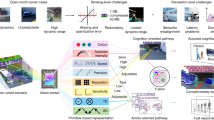Abstract
LARGE changes in the direction of gaze are made with a combina-tion of fast saccadic eye movements and rather slower head move-ments. Since the first study on freely moving subjects1, most authors have agreed that the head movement component of gaze is very variable, with a high ‘volitional’ component2. But in some circum-stances head and eye movements can be quite predictable, for example when a subject is asked to shift gaze as quickly as possible3. Under these conditions, laboratory studies have shown that the eye and head motor-systems both receive gaze-change commands, although they execute them in rather different ways3–6. Here I reconsider the way gaze direction is changed during free movement, but in the performance of a task where the subject is too busy to exert conscious control over head or eye movements. Using a new portable and inexpensive method for recording head and eye movements, I examine the oculomotor behaviour of car drivers, particularly during the large gaze changes made at road junctions. The results show that the pattern of eye and head movements is highly preditable, given only the sequence of gaze targets.
This is a preview of subscription content, access via your institution
Access options
Subscribe to this journal
Receive 51 print issues and online access
$199.00 per year
only $3.90 per issue
Buy this article
- Purchase on Springer Link
- Instant access to full article PDF
Prices may be subject to local taxes which are calculated during checkout
Similar content being viewed by others
References
Collewijn, H. In Control of Gaze by Brian Stem Neurons (eds Baker, R. & Berthoz, A.) 13–22 (Elsevier, New York, 1977).
Zangemeister, W. H. & Stark, L. Expl Neurol. 77, 563–577 (1982).
Zangmeister, W. H., Jones, A. & Stark, L. Expl Neurol. 71, 76–91 (1981).
Bizzi, E., Kalil, R. E. & Tagliasco, V. Science 173, 452–454 (1971).
Delreux, V., Abeele, S. V., Lefevre, P. & Roucoux, A. in Brain and Space (ed. Paillard, J.) 38–48 (Oxford Univ. Press, Oxford, 1991).
Becker, W. in Vision and Visual Dysfunction. Vol. 8, (ed. Carpenter, R. H. S.) 95–137 (Macmillan, Basingstoke, 1991).
Land, M. F., Marshall, J. N., Brownless, D. & Cronin, T. W. J. comp. Physiol. A167, 155–166 (1990).
Morasso, P., Bizzi, E. & Dichgans, J. Expl Brain Res. 16, 492–500 (1973).
Yarbus, A. L. Eye Movements and Vision (Plenum, New York, 1967).
Carpenter, R. H. S. Movements of the Eyes (Pion, London, 1988).
Laurutis, V. P. & Robinson, D. A. J. Physiol., Lond. 373, 209–233 (1986).
Tomlinson, R. D. J. Neurophysiol. 64, 1873–1891 (1990).
Guitton, D. Trends Neurosci. 15, 174–179 (1992).
Author information
Authors and Affiliations
Rights and permissions
About this article
Cite this article
Land, M. Predictable eye-head coordination during driving. Nature 359, 318–320 (1992). https://doi.org/10.1038/359318a0
Received:
Accepted:
Issue Date:
DOI: https://doi.org/10.1038/359318a0
This article is cited by
-
Drivers use active gaze to monitor waypoints during automated driving
Scientific Reports (2021)
-
Dynamic scan paths investigations under manual and highly automated driving
Scientific Reports (2021)
-
Humans Use Predictive Gaze Strategies to Target Waypoints for Steering
Scientific Reports (2019)
-
Mind the step: complementary effects of an implicit task on eye and head movements in real-life gaze allocation
Experimental Brain Research (2012)
-
An integrated head pose and eye gaze tracking approach to non-intrusive visual attention measurement for wide FOV simulators
Virtual Reality (2012)
Comments
By submitting a comment you agree to abide by our Terms and Community Guidelines. If you find something abusive or that does not comply with our terms or guidelines please flag it as inappropriate.



